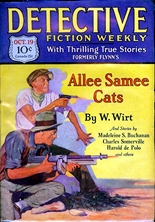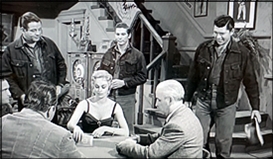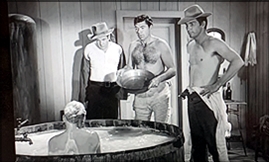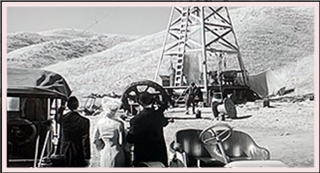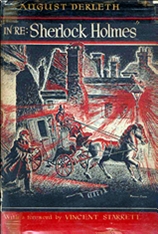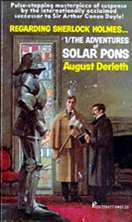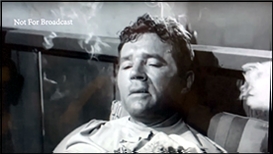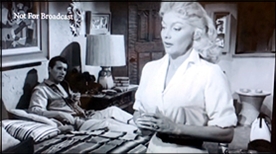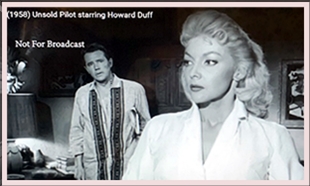Mon 3 Jul 2023
The Amazing Colossal Belgian: A Quartet of Christie Expansions Part 1: The Mystery of the Blue Train by Matthew R. Bradley
Posted by Steve under Reviews[10] Comments
A Quartet of Christie Expansions
Part 1: The Mystery of the Blue Train
by Matthew R. Bradley
Agatha Christie often reworked her stories into other forms, including several featuring Hercule Poirot. “The Submarine Plans†(The Sketch, November 7, 1923) was expanded into “The Incredible Theft†(serialized in the London Daily Express, April 6-12, 1937), and “The Mystery of the Baghdad Chest†(The Strand Magazine, January 1932) as “The Mystery of the Spanish Chest†(serialized in Women’s Illustrated, September 17-October 1, 1960). “The Adventure of the Christmas Pudding†(aka “Christmas Adventureâ€; The Sketch, December 12, 1923) became a novella (aka “The Theft of the Royal Rubyâ€) first published in The Adventure of the Christmas Pudding and a Selection of Entrées (1960).
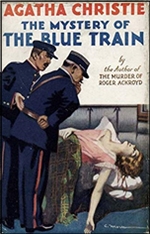
Christie sometimes exchanged one of her many sleuths for another; what appeared in The Strand Magazine (June 1936) as “Poirot and the Regatta Mystery†was rewritten with the lesser-known Parker Pyne before its book publication in The Regatta Mystery and Other Stories (1939). The original, while collected in the 2008 U.K. version of Hercule Poirot: The Complete Short Stories, is not in the U.S. version. She expanded some stories into novels, e.g., “The Plymouth Express,†which originally appeared in The Sketch (as “The Mystery of the Plymouth Expressâ€; April 4, 1923), like most of those in Poirot’s Early Cases (1974), and was collected in the U.S. in The Under Dog and Other Stories (1951). The expanded version became The Mystery of the Blue Train (William Collins & Sons, 29 March 1928).
First published Stateside in The Blue Book Magazine (as “The Plymouth Express Affairâ€; January 1924), the short story is narrated by Poirot’s friend and flatmate, Captain Arthur Hastings, as were the majority of them, although he appears in only eight novels. Shortly after Royal Navy Lt. Alec Simpson discovers Mrs. Flossie Carrington, stabbed to death, under the seat of a compartment in the titular train, Poirot receives a note asking him to call on her father, Ebenezer Halliday, “the steel king of America,†for whom he once did a little service (“an affair of bearer bondsâ€). Her poor taste in men included her husband, the Hon. Rupert Carrington, and adventurer Count Armand de la Rochefour, a “bad hat.â€

The maid, Jane Mason, reported that, en route to a house party at Avonmead Court with $100,000 worth of jewels, Flossie had suddenly announced she would not change trains at Bristol, where Jane — who saw the back of an unknown man in the compartment — was ordered to await her with the luggage, minus the jewel case. Describing Flossie’s striking outfit, she says she thinks the tall, dark man was not Rupert, a fortune-hunter from whom a legal separation was imminent. Sensing that Halliday is holding something back, Poirot threatens to decline the case, until he reveals a letter found in Flossie’s handbag from the Count, who was about to renew their acquaintance…and also matches Jane’s description.
Poirot and Hastings meet with their old friend Inspector Japp of Scotland Yard (making a Sherlock Holmes/Dr. Watson/Inspector Lestrade parallel), who is astounded when Poirot correctly predicts that he has found the murder weapon, “by the side of the line between Weston and Taunton,†and interviewed the paperboy whom Flossie generously tipped at Weston. Learning that one of the “shiners†has been pawned by Red Narky, a jewel thief apparently working without usual accomplice Gracie Kidd, Poirot hastens with Hastings to Halliday’s, where he finds a duplicate outfit in Jane’s trunk. Jane is, of course, Gracie, who impersonated Flossie, and ensured that the paperboy would remember her ensemble.
“It was of the most simple!,†declares Poirot, who explains that after Gracie and Red had chloroformed and stabbed Flossie between London and Bristol, she had taken her place, “[throwing] the knife out of the window to mark the place where the crime presumably occurred.†She deliberately described a man whose appearance was the exact opposite of Narky’s, and neither the Count — “much too careful of his own skin to risk murder†— nor Rupert was involved. Such stories obviously inspired the Monty Python sketch about the “West End hit It All Happened on the 11.20 from Hainault to Redhill via Horsham and Reigate, Calling at Carshalton Beeches, Malmesbury, Tooting Bec, and Croydon West.â€
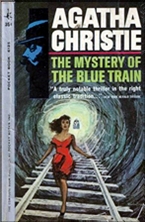
As with “The Plymouth Express†and The Mystery of the Blue Train, Christie expanded the posthumously published “The Incident of the Dog’s Ball†and “Hercule Poirot and the Greenshore Folly†into, respectively, Dumb Witness (aka Poirot Loses a Client; 1937) and Dead Man’s Folly (1956). Interestingly, the story (1991) and the novel (2005) were adapted separately, with David Suchet, for Agatha Christie’s Poirot. Featuring the first appearances of Poirot’s valet, George(s), and private investigator Mr. Goby, next seen in After the Funeral (aka Funerals Are Fatal; 1953), the novel is set partly in the village of St. Mary Mead in Kent (presumably distinct from Miss Marple’s home west of London).
The Mystery of the Blue Train was also adapted for BBC Radio in 1985-6, with Maurice Denham — who played Japp on film in The Alphabet Murders (1965), and Pyne on TV in The Agatha Christie Hour — as Poirot, and as a graphic novel in 2007. Christie reportedly said of this novel in her autobiography that she “always hated it,†not so surprising when financial need had forced her to return to writing after her mother’s death; the infidelity of her soon-to-be-ex-husband, Archie Christie; a breakdown; and the mysterious eleven-day disappearance dramatized with Vanessa Redgrave in the film Agatha (1979). It was first serialized in London’s The Star (February 1-March 15, 1928), minus two initial chapters.
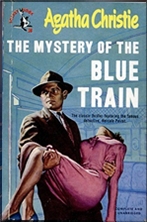
These backtrack (as it were) to before the murder, while the closest any character names in this third-person narrative come to the story’s are Ada Mason and the Comte Armand de la Roche. In Paris, American millionaire Rufus Van Aldin — later said by Marie Van Schuyler to be a friend of hers in Death on the Nile (1937) — buys a small parcel from a Russian, who observes both the pair following Rufus and a white-haired man taken to be their employer. After learning that these “Apaches†were repulsed with a revolver, M. le Marquis dons a mask to visit antiques dealer Demetrius Papopolous and his daughter Zia; reporting this failed attempt to steal the rubies, he vows, “The other plan — will not fail.â€
In London, Van Aldin is greeted at the Savoy by his secretary, Major Richard Knighton, and a troubling letter from his daughter, Ruth Kettering, to whom he brings the rubies — worn by Catherine of Russia and including the flawless Heart of Fire — as gifts. His son-in-law, Derek, has been cavorting with exotic dancer Mirelle, so he advises a divorce and hires Goby to investigate him; Derek darkly hints that Ruth has her own secrets, and on his way to see her Rufus spots Armand, from whose clutches he extricated her years ago, leaving her building. Mirelle notes that her death would be convenient, and tells Derek that Ruth — ostensibly headed to the Riviera — is really planning to meet Armand in Paris.
In St. Mary Mead, Katherine Grey inherits a fortune from Jane Harfield, to whom she had been a paid companion, and departs for London. There, she receives an invitation from a cousin, Viscountess Rosalie Tamplin, to her Riviera home, the Villa Marguerite; the Hon. Lenox Tamplin, her daughter, instantly sees through it, since her fourth husband, Charles “Chubby†Evans, has no money whatever, yet while also not deceived, Katherine accepts as a change from her sheltered life. At Thomas Cook & Sons she sees Derek, a stranger who’d bumped into her at the Savoy, also booked a berth on the Blue Train, and refuses Rufus’s offer — conveyed by Knighton — of £100,000 if he will not contest their divorce.
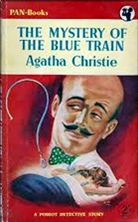
On the train, Katherine sees Ruth, who’d shared her Pullman coach from Victoria Station to Dover, and unburdens herself to the stranger in the dining car; Poirot, boarding in Paris at the Gare de Lyon; and Derek, curious if this is the lover of whom Ruth spoke. Met by Chubby in Nice, Katherine is informed by M. Caux, the Commissary of Police, that Ruth has been found strangled and the maid, Ada, has vanished, so only with this revelation in Chapter 11, a third of the way through the novel, do Christie’s two narratives even begin to synch up. Poirot offers his assistance, while she identifies Ruth — “disfigured…almost beyond recognition†with a heavy post-mortem blow — by the mole on the victim’s wrist.
The jewel-case is missing, and Ruth had said she’d left Ada behind in Paris, according to attendant Pierre Michel, apparently not the same conductor in the oft-adapted Murder on the Orient Express (aka Murder in the Calais Coach; 1934). At a dinner party, Katherine is introduced to Derek, of whom she had not told M. Caux, and he is informed of Ruth’s death; Goby reveals that he and Mirelle were aboard, and Ada, seen by Knighton in Paris, is questioned by Examining Magistrate M. Carrège. He shows Rufus the letter from the Comte, ostensibly writing about famous jewels, and Poirot, while convinced that murder is inconsistent with his psychology, reports that he has leased the Villa Marina at Antibes.
With Derek inheriting £2 million, Rufus asks Poirot to investigate, but despite his flimsy alibi, Ada cannot identify Armand conclusively; Derek denies that he knew Ruth was on the train, yet is aware of the rubies. At the Negresco, Derek sees Mirelle, who thinks he killed Ruth for her, but is told he is done with her, so she introduces herself to the Comte, stating that the police suspect him and suggesting he finger Derek. Poirot and Katherine meet with Rufus, and she makes a favorable impression upon Knighton, who in a nicely metafictional moment tells her, “You confess that you read detective stories, Miss Grey. You must know that any one who has a perfect alibi is always open to grave suspicion.â€

At a tennis match, Poirot points out to Rufus the sudden appearance of M. Papopolous in Nice, then produces the rubies, recovered from the accommodation address to which the Comte, under surveillance, mailed the parcel. Visiting the Greek, to whom he once did a service, Poirot displays the jewels — which are imitations — and says he is concerned only with the murder, not with recovering the originals, so he is given a tip on M. le Marquis. He believes that Armand planned a substitution, but was pre-empted by murder, and the Comte, claiming innocence, tries to blackmail Derek with information from Mirelle, who says she saw Kettering emerge from Ruth’s compartment just before they reached Lyons.
Minutes apart, Derek and Knighton seek to marry Katherine, recalling Lucy Westenra’s three-proposal day in Dracula (1897); Mirelle tells the police her tale but is evasive about how she knew Ruth was dead when the train left Lyons, and George notes that, seeking a new situation, he had read in Society Snippets about Poirot being received at Buckingham Palace. Poirot leaves news of Derek’s arrest with Lenox, who says the killer could have boarded and left the train after strangling Ruth, while Zia, reminded of a secret he’d kept for her, reveals that her father has the rubies. Armand’s servant admits he’d arrived a day later than claimed, and Poirot theorizes that Mirelle found Ruth dead in her compartment.
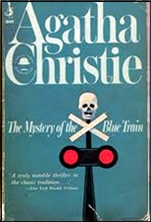
Homesick after receiving a letter from elderly Amelia Viner in St. Mary Mead, Katherine returns to England when she learns that Knighton and Rufus are as well, and becomes her new companion. Poirot consults his friend Joseph Aarons — a theatrical agent introduced in The Murder on the Links (1923) — about male impersonator and character actress Kitty Kidd, who had quit the stage three years earlier. Mirelle has taken up with the ex-Prime Minister of Greece and now sports the Heart of Fire, clearly sold to him by Papopolous; lunching with Katherine, Poirot says the disfigurement is central to his doubt that Derek is actually guilty, and that “the robbery and the murder were done by the same person.â€
Poirot has Rufus and Knighton return with him to the south of France on the Blue Train, where he reveals that a “youth†seen leaving the train at Lyons was Kitty (aka Ada), and Knighton, who’d feigned a limp from a war wound to facilitate his dual identity of M. le Marquis, boarded in Paris just long enough to kill Ruth. As Poirot tells Van Aldin, they had planned to scapegoat the Comte, but after his cigarette case, bearing the initial “K,†was found in her cabin, they’d hit upon Kettering as the man she’d allegedly seen. Ada, posing as Ruth, had told Pierre that the maid was left in Paris, hence the disfigurement to conceal her imposture, and thus Derek, cleared and released, leaves for St. Mary Mead…
Up next: “Murder in the Mewsâ€
Editions cited:
“The Plymouth Express†in Hercule Poirot: The Complete Short Stories: William Morrow (2013)
The Mystery of the Blue Train: Pocket (1940)

